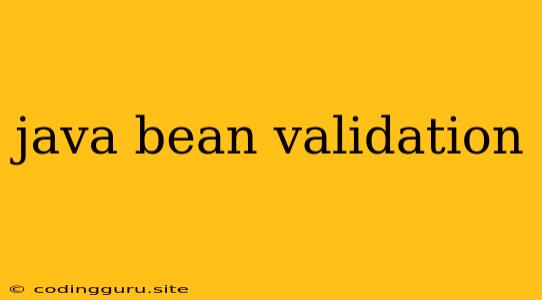Java Bean Validation: A Comprehensive Guide to Data Validation
Java Bean Validation is a powerful and widely used framework for validating Java objects. It provides a standard way to enforce constraints on your data, ensuring data integrity and preventing errors from creeping into your application. This article will guide you through the key concepts of Java Bean Validation, its benefits, and practical examples.
Why Java Bean Validation?
Why is validation crucial? Imagine a scenario where a user submits a form with invalid data. This could lead to a multitude of issues:
- Incorrect data storage: Invalid data can corrupt your database, making your application unreliable and potentially causing data loss.
- Unexpected program behavior: Your application might throw exceptions or behave unpredictably when encountering invalid data.
- Security vulnerabilities: Unvalidated user inputs can be exploited by malicious actors, leading to security breaches.
Java Bean Validation comes to the rescue! It simplifies the process of validating data in your Java applications by providing:
- A standard, declarative way to define constraints: This means you can easily specify validation rules directly on your Java objects using annotations.
- Built-in support for common validation checks: Java Bean Validation provides a wide range of pre-defined constraints like
@NotNull,@NotEmpty,@Size,@Email, and more. - Flexibility for custom validation rules: You can easily create your own custom validation logic using annotations and interfaces.
- Integration with other frameworks: It integrates seamlessly with popular Java frameworks like Spring and Jakarta EE.
The Core Concepts of Java Bean Validation
1. Annotations: Java Bean Validation leverages annotations to define constraints on your Java objects. These annotations are placed directly on the fields or methods of your class.
Examples:
- @NotNull: Ensures that a field cannot be null.
- @NotBlank: Ensures that a string field is not blank (trimmed and not empty).
- @Size(min=2, max=10): Specifies the minimum and maximum length for a string field.
- @Email: Validates if a field represents a valid email address.
2. ConstraintValidator: This interface is used to implement custom validation logic. You create a class that implements ConstraintValidator and define the validation logic within its isValid method.
3. ConstraintValidatorContext: This object is passed to the isValid method and provides access to contextual information related to the validation process.
4. Validation API: This API provides the core functionality for validating Java objects and offers various methods for performing validation, retrieving validation errors, and customizing the validation process.
Implementing Java Bean Validation
Let's illustrate how to implement Java Bean Validation with a simple example. Suppose we have a User class:
public class User {
@NotNull
private String name;
@NotBlank
private String email;
@Size(min=8, max=20)
private String password;
// Getters and setters
}
In this example, we've applied annotations to the name, email, and password fields.
To validate a User object:
// Inject the Validator
@Inject
private Validator validator;
// Validate the User object
Set> violations = validator.validate(user);
// Check if there are any violations
if (violations.isEmpty()) {
// No validation errors, proceed with the operation
} else {
// Handle validation errors
for (ConstraintViolation violation : violations) {
System.err.println("Error: " + violation.getMessage());
System.err.println("Field: " + violation.getPropertyPath());
}
}
Explanation:
- We inject the
Validatorinterface, which is responsible for executing the validation process. - We call the
validatemethod on theValidatorinstance, passing theUserobject to be validated. - The
validatemethod returns aSetofConstraintViolationobjects, representing any validation errors. - We iterate through the
violationsset and print the error messages and affected fields.
Beyond Basic Validation
Custom Validation: Let's say you need a custom validation rule for a specific field, like a custom password validation:
@Target({METHOD, FIELD, ANNOTATION_TYPE, CONSTRUCTOR, PARAMETER, TYPE_USE})
@Retention(RUNTIME)
@Constraint(validatedBy = StrongPasswordValidator.class)
public @interface StrongPassword {
String message() default "Password is not strong enough";
Class[] groups() default {};
Class[] payload() default {};
}
public class StrongPasswordValidator implements ConstraintValidator {
@Override
public boolean isValid(String password, ConstraintValidatorContext context) {
// Custom password strength validation logic
// ...
}
}
This example creates a custom annotation @StrongPassword with a corresponding StrongPasswordValidator class that implements the custom validation logic.
Integration with Frameworks:
Java Bean Validation integrates seamlessly with popular frameworks:
- Spring: Spring provides support for Java Bean Validation through its
@Validatedannotation and theMethodValidationPostProcessor. - Jakarta EE: Jakarta EE includes the
javax.validationpackage and supports Java Bean Validation out-of-the-box.
Conclusion
Java Bean Validation is an invaluable tool for any Java developer. It simplifies the process of validating data, ensures data integrity, and helps to prevent bugs and security vulnerabilities. By using annotations and the Validator API, you can easily implement basic and custom validation rules for your Java objects. Leveraging this framework will not only make your code more robust but also enhance the overall quality and reliability of your applications.
